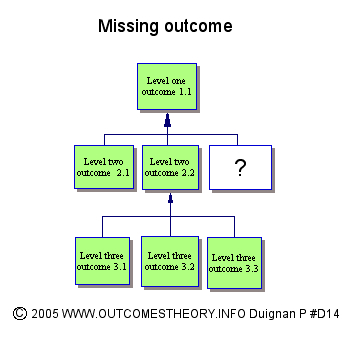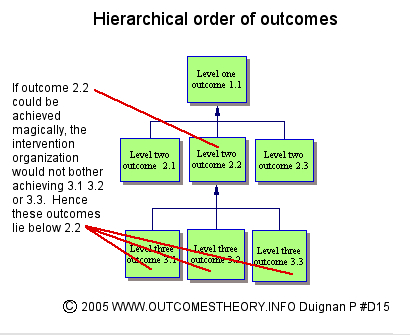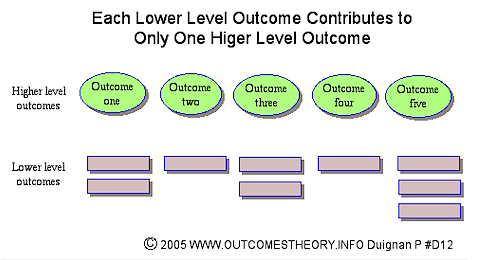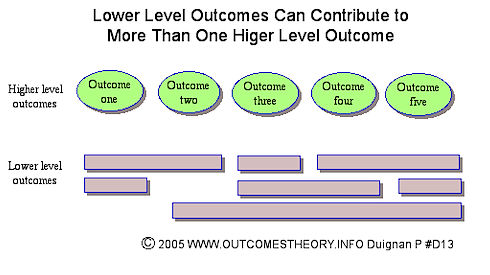Principle: Influencing outcome set completeness - The set of outcomes which influence any outcome must contain all of the lower level outcomes which are necessary for the achievement of an outcome under normal circumstances. [Provisional only]
Example: The diagram below shows an example of an outcomes hierarchy which lacks an outcome on the right hand side which is essential for the achievement of the the top level outcome.

Principle: Outcomes vertical relationship - One outcome sits above another outcome in an outcomes hierarchy if its achievement would mean that an intervention organization would not bother to achieve an outcome below which is one of its influencers.
Example: The diagram below shows the vertical relationship of outcomes. 
Principle: Outcome influence on single or multiple higher-level outcome - Any outcome can influence either a single or multiple higher-level outcomes within an outcomes hierarchy.
Discussion: In the diagram below the lower level outcomes only influence a single higher level outcome.

In the diagram below the lower lever outcomes influence a number of higher-level outcomes.

Principle: All possible causal relationships should be allowed between outcomes - Outcomes hierarchies should be allowed to potentially include all possible causal relationships (e.g. both positive and negative) so that they can be representations of "cascading set of causes in the real world".
Discussion: There is a tendency when drawing outcomes hierarchies to not include within them both positive and negative relationships. This limits the use such outcomes hierarchies because they do not represent the "real world" in which an intervention is being attempted. Allowing both positive and negative relationships allows for outcomes hierarchies to include trade-offs between high-level outcomes. Sometimes this issue is dealt within outcomes systems by not allowing negative relationships within outcomes hierarchies but by accompanying outcomes hierarchies with tables. Such tables typically include what are termed "risks" and "assumptions" regarding the outcomes hierarchy. From a theoretical point of view such risks and assumptions can be simply regarded as a type of outcome. Risks are outcomes which if they increase have a negative effect on a preferred outcome within the outcomes hierarchy and assumptions are outcomes which it is hoped will not change in the course of the achievement of the outcomes hierarchy [Provisional only]. While this is a possible way of approaching the issue, it means that, firstly, the outcomes hierarchies which are represented are not complete outcomes hierarchies. Secondly, it prevents the use of the outcomes hierarchy within an outcomes system as the backbone for structuring indicator sets (I[n-att] and I[att]), whole-intervention high-level outcomes attribution evaluation (W) and any additional lower-level evaluation (A).
V1-0.
